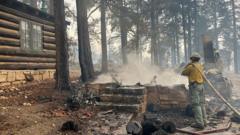National parks and forests across the United States are facing significant challenges due to recent job cuts implemented by the Trump administration. These reductions in staff have not only created longer wait times and closed facilities for visitors, but have also jeopardized the safety and maintenance of these vital natural landscapes.
Cuts to America’s National Parks Spark Public Outcry

Cuts to America’s National Parks Spark Public Outcry
The Trump administration’s job cuts at national parks and forests lead to rising concerns over conservation and access.
The fallout from the mass dismissals, which impacted thousands of employees, has raised serious concerns about the future of public safety and conservation efforts as the nation approaches the busy vacation months.
With changes that started on February 14, the National Park Service saw approximately 5% of its workforce, or about 1,000 employees, laid off. The US Forest Service experienced an even more drastic impact, losing around 10% of its workforce, amounting to about 3,400 employees. This mass termination has hindered the ability to maintain popular hiking trails and manage essential visitor services, leading to significant lines and delays at parks such as the Grand Canyon.
Kate White, a wilderness ranger in Washington, voiced her worries about the state of the Enchantments, a popular alpine area where sanitation issues and visitor safety are concerned. With fewer staff available, she fears dangers could rise, and accidents might increase as the number of unprepared visitors grows. Furthermore, employees like Andria Townsend, a former biologist at Yosemite, are voicing their apprehensions regarding the potential harm to endangered species directly linked to reduced research and conservation work.
While some former employees have opted to protest against the cuts, stating that vital wildlife research and public safety efforts are in jeopardy, others have been re-hired in response to public backlash. Interior Secretary Doug Burgum has promised to recruit over 5,000 seasonal workers for the summer months.
Yet, outdoor advocates warn that visitors should brace for a frustrating experience that may include inadequate facilities, increased litter, and limited services during their anticipated trips to these natural treasures. The upcoming summer season puts these changes into sharp relief, as both the safety and enjoyment of visitors hangs in the balance with each decision made by the administration.
As public outcry grows, the administration will be under pressure to address the ramifications of the cuts and ensure the preservation of national parks for future generations.
With changes that started on February 14, the National Park Service saw approximately 5% of its workforce, or about 1,000 employees, laid off. The US Forest Service experienced an even more drastic impact, losing around 10% of its workforce, amounting to about 3,400 employees. This mass termination has hindered the ability to maintain popular hiking trails and manage essential visitor services, leading to significant lines and delays at parks such as the Grand Canyon.
Kate White, a wilderness ranger in Washington, voiced her worries about the state of the Enchantments, a popular alpine area where sanitation issues and visitor safety are concerned. With fewer staff available, she fears dangers could rise, and accidents might increase as the number of unprepared visitors grows. Furthermore, employees like Andria Townsend, a former biologist at Yosemite, are voicing their apprehensions regarding the potential harm to endangered species directly linked to reduced research and conservation work.
While some former employees have opted to protest against the cuts, stating that vital wildlife research and public safety efforts are in jeopardy, others have been re-hired in response to public backlash. Interior Secretary Doug Burgum has promised to recruit over 5,000 seasonal workers for the summer months.
Yet, outdoor advocates warn that visitors should brace for a frustrating experience that may include inadequate facilities, increased litter, and limited services during their anticipated trips to these natural treasures. The upcoming summer season puts these changes into sharp relief, as both the safety and enjoyment of visitors hangs in the balance with each decision made by the administration.
As public outcry grows, the administration will be under pressure to address the ramifications of the cuts and ensure the preservation of national parks for future generations.





















